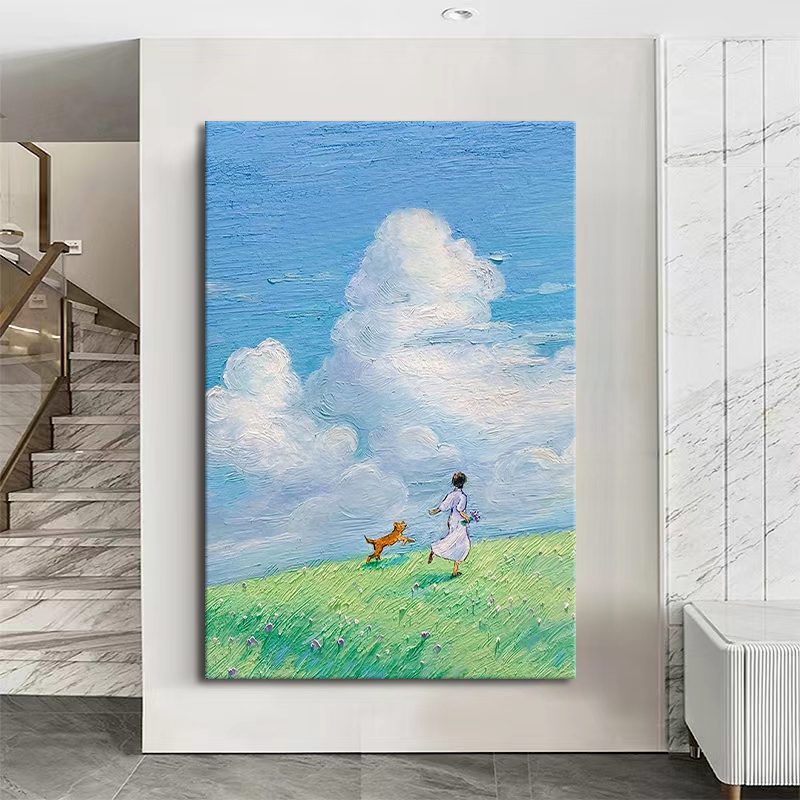Thick coating is a highly expressive technique in hand-painted oil painting. By piling up pigments in thick layers on the canvas, it creates a unique visual effect and artistic texture. The following elaborates on its effects in detail from several aspects such as picture texture, color expression, light and shadow effect, and emotional communication:
Enhance the texture of the picture
Simulating real materials: The thick coating method can well simulate the real texture of various objects. For instance, when depicting metal objects, the thick coating method is used to accumulate pigments, and then the luster and uneven texture of the metal surface are shaped through a scraper or brush, making the metal appear hard, cold and reflective. When painting leather products, thickly applied pigments can show the roughness, softness and texture of the leather, allowing the audience to feel as if they could touch the texture of the leather.
Creating a sense of depth and three-dimensionality: The thickly applied pigment layer gives the picture a strong sense of depth and three-dimensionality. The undulating patterns formed by the accumulation of pigments on the canvas are like sculptures, making the objects in the picture more three-dimensional and realistic. For instance, when drawing a mountain peak, the thick coating method is used to stack the pigments layer by layer to show the grandeur and perilousness of the mountain peak, giving the audience a sense of being right there.
Rich color expression
High color saturation: The thick coating method uses more pigments, resulting in higher color saturation, making the colors more vivid and rich. Compared with the light and elegant tones applied thinly, the thickly applied colors are more visually striking and can attract the audience’s attention. For example, when painting an oil painting with flowers as the theme, the thickly painted petals are bright and eye-catching in color, making the flowers look full of vitality.
Rich color gradation: As pigments can be superimposed in multiple layers, the thick coating method can create rich color gradation. Pigments of different colors interpenetrate and blend with each other, creating subtle color variations. For example, when drawing the sky, the thick transition from light blue to dark blue can show the depth and layering of the sky. When drawing the skin tone of a character, by thickly applying pigments of different colors, the delicate changes in skin tone and the effects of light and shadow can be presented.
Enhance the light and shadow effect
Highlighting the contrast of light and shade: The thick coating method can better represent the contrast of light and shade of objects. Using thicker pigments in the bright areas can enhance the reflection of light and make the bright areas brighter. In the dark areas, use less pigment or add dark pigments to make the dark areas darker. This strong contrast of light and dark can highlight the three-dimensional effect and spatial sense of objects, making the picture more vivid. For instance, when drawing a sphere, by using the thick coating method to apply white or light-colored pigments to the bright parts of the sphere and black or dark-colored pigments to the dark parts, the changes in light and shadow of the sphere can be clearly presented.
Create a unique light and shadow atmosphere: Thickly applied pigments can form irregular brushstrokes and textures, which will produce unique light and shadow effects under the illumination of light. For instance, when painting a night scene oil painting, thick layers of paint can convey the mystery and tranquility of the night. Through the interplay and reflection of light and shadow, a dreamlike atmosphere is created.
Facilitate emotional communication
Expressing intense emotions: The heavy and intense texture and color presented by the thick coating method can effectively convey the artist’s intense emotions. When artists want to express intense emotions such as anger, passion and joy, the thick coating method can make the picture more infectious. For instance, in an oil painting depicting a war scene, the thick application of pigments and the strong contrast of colors can convey the cruelty and intensity of the war, allowing the audience to feel the artist’s criticism and reflection on the war.
Reflecting artistic individuality: Each artist has their own unique style and techniques when using the thick coating method, which reflect the artist’s individuality and creativity. Through the thick coating method, artists can freely express their artistic concepts and aesthetic pursuits, endowing their works with unique artistic value. For instance, some artists prefer to use rough and bold thick brushstrokes to express the power of nature and the vitality of life, while others pay more attention to delicate and exquisite thick coating effects to showcase the beauty and emotions of objects.
